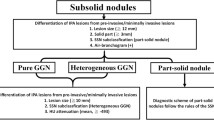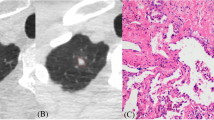Abstract.
The aim of this study was to evaluate differences in the prevalence of patterns of CT bronchus sign in malignant solitary pulmonary lesions (SPLs), according to their histologic cell types and with respect to size, location, and degree of cell differentiation. Computed tomography scans of 78 patients, in whom pathologically confirmed malignant SPLs with CT bronchus sign were present, were randomly selected and reviewed by two radiologists under consensus. All 78 were CT scans done using spiral technique with 10-mm collimation and 10-mm reconstruction intervals with enhancement, and 75 included additional high-resolution CT scans. Lesions were classified into four cell types as squamous cell carcinoma (n = 24), small cell carcinoma (n = 12), adenocarcinoma (n = 23), bronchioloalveolar carcinoma (BAC; n = 9), and others (n = 12), into three degrees of differentiation, into three size groups, and according to location (central or peripheral). Patterns of CT bronchus sign were classified into abruptly obstructing (I), patent (II), displacing (III), or tapered narrowing (IV) types. The relationships between the patterns of CT bronchus sign and cell type and degree of cell differentiation were evaluated. Eighty patterns of CT bronchus sign were observed in 78 patients. According to cell type, squamous cell carcinoma showed most often type-I pattern (45.8 %) but no type-II pattern, which was the most common pattern observed in BAC (77.8 %) and adenocarcinoma (34.8 %; p < 0.01). Small cell carcinoma showed a varied distribution among the four patterns of CT bronchus sign. According to location, in central squamous cell carcinomas, type-I pattern was more common(55 %; p < 0.01). Bronchioloalveolar carcinoma showed more peripheral lesions and in both central and peripheral lesions, type-II pattern was significantly more common (100 and 66.7 %; p < 0.01). In SPLs with CT bronchus sign of obstructing pattern, especially if central location, squamous cell carcinoma should be suspected, whereas in SPLs with patent CT bronchus sign, regardless of the location, the strong possibility of BAC should be considered.
Similar content being viewed by others
Author information
Authors and Affiliations
Additional information
Received: 15 March 1999; Revised: 8 July 1999; Accepted: 28 December 1999
Rights and permissions
About this article
Cite this article
Choi, JA., Kim, J., Hong, K. et al. CT bronchus sign in malignant solitary pulmonary lesions: value in the prediction of cell type. Eur Radiol 10, 1304–1309 (2000). https://doi.org/10.1007/s003300000315
Issue Date:
DOI: https://doi.org/10.1007/s003300000315




